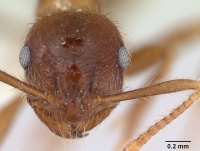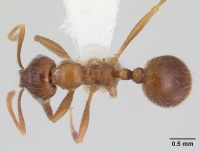Kartidris nyos
| Kartidris nyos | |
|---|---|

| |
| Scientific classification | |
| Kingdom: | Animalia |
| Phylum: | Arthropoda |
| Class: | Insecta |
| Order: | Hymenoptera |
| Family: | Formicidae |
| Subfamily: | Myrmicinae |
| Tribe: | Crematogastrini |
| Genus: | Kartidris |
| Species: | K. nyos |
| Binomial name | |
| Kartidris nyos Bolton, 1991 | |
Identification
Distribution
Latitudinal Distribution Pattern
Latitudinal Range: 25.84667° to 25.84666667°.
| North Temperate |
North Subtropical |
Tropical | South Subtropical |
South Temperate |
- Source: AntMaps
Distribution based on Regional Taxon Lists
Oriental Region: India (type locality).
Palaearctic Region: China.
Distribution based on AntMaps
Distribution based on AntWeb specimens
Check data from AntWeb
Countries Occupied
| Number of countries occupied by this species based on AntWiki Regional Taxon Lists. In general, fewer countries occupied indicates a narrower range, while more countries indicates a more widespread species. |

|
Estimated Abundance
| Relative abundance based on number of AntMaps records per species (this species within the purple bar). Fewer records (to the left) indicates a less abundant/encountered species while more records (to the right) indicates more abundant/encountered species. |

|
Biology
Castes
Nomenclature
The following information is derived from Barry Bolton's Online Catalogue of the Ants of the World.
- nyos. Kartidris nyos Bolton, 1991: 12, figs. 18, 19 (w.) INDIA (Meghalaya).
- Type-material: holotype worker, 5 paratype workers..
- Type-locality: holotype India: Meghalaya, Khasi Hills, Shillong, 10.v.1975 (R. Mathew); paratypes with same data.
- Type-depositories: BMNH (holotype); BMNH, MCZC (paratypes).
- Status as species: Bolton, 1995b: 219; Xu, 1999: 134 (in key); Zhang, W. & Zheng, 2002: 220; Bharti, Guénard, et al. 2016: 37.
- Distribution: China, India.
Unless otherwise noted the text for the remainder of this section is reported from the publication that includes the original description.
Description
Worker
Holotype. TL 4.4, HL 0.96, HW 0.83, CI 86, SL 0.90, SI 108, PW 0.60, AL 1.24. Maximum diameter of eye 0.21 (0.25 x HW) and with 10-11 ommatidia in the longest row. Mandibles finely longitudinally rugulose. Entire cephalic dorsum with only vestigial sculpture, a very feeble superficial reticulation visible. Median portion of clypeus conspicuously biconvex, without longitudinal carinae. Eyes with abundant anteriorly curved short hairs arising between the facets. Dorsal alitrunk virtually smooth except for the propodeum, which shows weak reticulation. Dorsal outline of propodeum rounded immediately behind the metanotal groove. Sides of pronotum shining, almost unsculptured. Mesopleuron densely sculptured, reticulate-punctate with some fine longitudinal rugulae. Sides of propodeum and metapleuron with sculpture intermediate in density between pronotum and mesopleuron. First gastral tergite with fine superficial shagreening between hairpits, almost smooth. Pilosity dense on all dorsal surfaces, the hairs erect to suberect everywhere. Scapes and tibiae with numerous suberect to subdecumbent short hairs. Colour light yellowish brown.
Paratype. TL 4.2-4.6, HL 0.92-0.98, HW 0.78-0.84, CI 85-88, S 0.86-0.92, SI 108-111, PW 0.59-0.62, AL 1.22-1.34. Maximum diameter of eye 0.20-0.22 (0.25-0.27 X HW) (4 measured). As holotype.
Type Material
Holotype worker, INDIA: Meghalaya, Khasi Hills, Shillong, 1O.v.1975 (R. Mathew) (The Natural History Museum).
Paratypes, 5 workers with same data as holotype (BMNH; Museum of Comparative Zoology).
References
- Bolton, B. 1991. New myrmicine genera from the Oriental Region (Hymenoptera: Formicidae). Syst. Entomol. 16: 1-13. (page 12, figs. 18, 19 worker described)
- Liu, C., Fischer, G., Hita Garcia, F., Yamane, S., Liu, Q., Peng, Y.Q., Economo, E.P., Guénard, B., Pierce, N.E. 2020. Ants of the Hengduan Mountains: a new altitudinal survey and updated checklist for Yunnan Province highlight an understudied insect biodiversity hotspot. ZooKeys 978, 1–171 (doi:10.3897/zookeys.978.55767).
References based on Global Ant Biodiversity Informatics
- Guénard B., and R. R. Dunn. 2012. A checklist of the ants of China. Zootaxa 3558: 1-77.
- Xu Z., Chen Z. and Hu G.. 1998. Five species of the ant genera Tetramorium, Kartidris and Lophomyrmex newly recorded in China (Hymenoptera: Formicidae). Journal of Southwest Forestry College 18: 236-240
- Zhang Z., M. Cao, X. Yang, X. Deng, and Y. She. 2000. A study on species diversity of ant in fragments of seasonal rain forest of Xishuangbanna, China. Zoological Research 21(1): 70-75.

